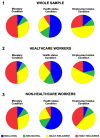Job loss and health threatening events modulate risk-taking behaviours in the Covid-19 emergency
- PMID: 33335136
- PMCID: PMC7746716
- DOI: 10.1038/s41598-020-78992-x
Job loss and health threatening events modulate risk-taking behaviours in the Covid-19 emergency
Abstract
Covid-19 pandemic is exerting a tragic impact all around the world. First-person experience of life-threatening and stressful events can modify individuals' risk perception, and, consequently, risk-taking behaviours. Here we investigated risk-taking profiles in 130 Italian residents, and compared healthcare to non-healthcare workers, during the lockdown phase. We ad hoc developed the "Covid-19 Risk Task", including the classic monetary Holt-Laury Paired Lottery Task (Monetary Condition, MC) and two new ecological conditions exploring Covid-19 related risk-taking aptitudes in relation to different health (Health Status Condition, HsC) and employment (Employment Status Condition, EsC) outcomes. Results showed that, in the whole sample, individuals were more risk-averse in MC than in HsC and EsC. Moreover, a payoff increase produced a shift toward more risk-averse behaviours in MC, but not in HsC and EsC, where we found an opposite trend suggesting a more risk-loving behaviour. Finally, we found that healthcare workers were significantly less risk-averse compared to non-healthcare workers in EsC, but not in MC and HsC. These findings provided evidence of the possible effects of Covid-19 outbreak on risk-taking aptitudes. The negative impact on human choices and, consequently, on the whole world economy of this catastrophic life event must not be underestimated.
Conflict of interest statement
The authors declare no competing interests.
Figures


References
-
- Cassar A, Healy A, von Kessler C. Trust, risk, and time preferences after a natural disaster: experimental evidence from Thailand. World Dev. 2017;94:90–105. doi: 10.1016/j.worlddev.2016.12.042. - DOI
-
- Cameron, L. & Shah, M. Risk-Taking Behavior in the Wake of Natural Disasters. (2013).
-
- Voors MJ, et al. Violent conflict and behavior: A field experiment in Burundi. Am. Econ. Rev. 2012;102:941–964. doi: 10.1257/aer.102.2.941. - DOI
-
- Kahneman D, Tversky A. Prospect theory: an analysis of decision under risk. Econometrica. 1979;47:263–292. doi: 10.2307/1914185. - DOI
-
- Jakiela P, Ozier O. The impact of violence on individual risk preferences: evidence from a natural experiment. Rev. Econ. Stat. 2019;101:547–559. doi: 10.1162/rest_a_00763. - DOI
MeSH terms
LinkOut - more resources
Full Text Sources
Medical

